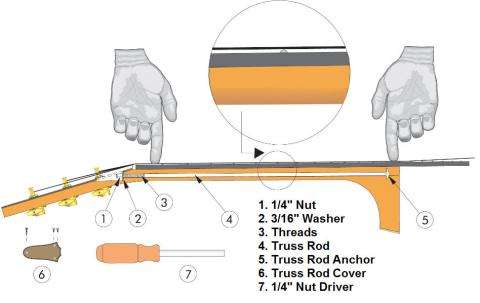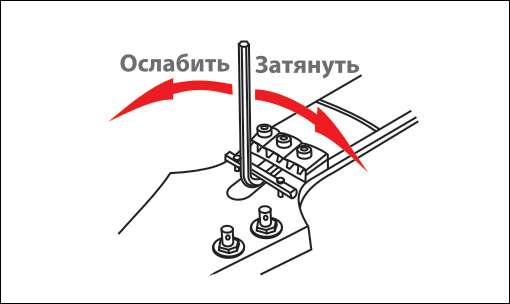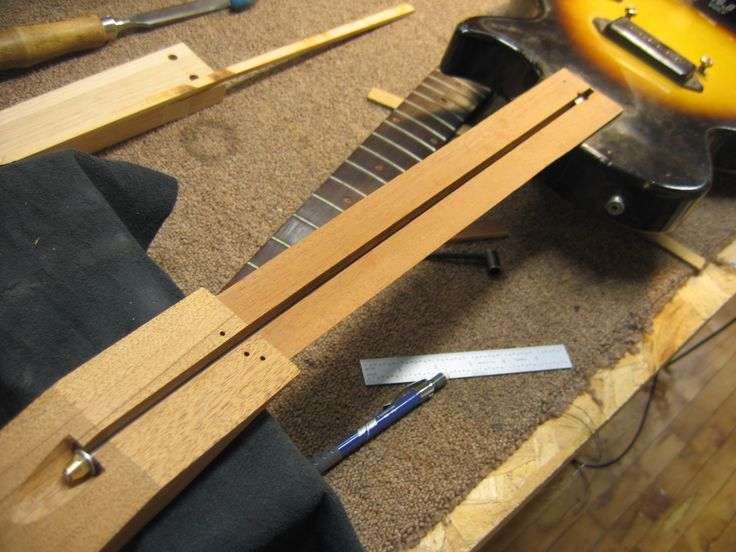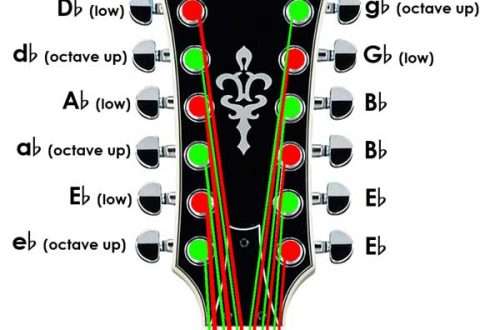
Tuning the truss on the guitar
Contents

A novice guitarist should not only know the notes and be able to play chords , but also have a good understanding of the physical part of his instrument. Detailed knowledge of material and construction helps to better understand the principles of sound production, and thus improve your playing skills.
Most virtuoso guitarists were well versed in the production of instruments, which allowed them to order unique guitars with a specific set of instruments.
About the guitar truss
Both acoustic and electronic guitars have an anchor in their structure – a special fastening and regulating device. It is a long metal stud or threaded strip, and two heads. Being inside the fretboard a, it is not visible during external examination, so many people far from music are not even aware of its existence. However, it is with its help that the instrument sounds as it should, and you can play it correctly and without unnecessary difficulties.
What is an anchor for?
Most modern guitars have metal strings. Their elasticity is much less than that of nylon, so when tuned they have a strong effect on the neck , causing it to bend at an angle towards the top. A strong deflection of the fretboard a leads to an uneven distance from the strings to the fretboard a. At the zero nut, they can be above the very fret , and at the 18th, they can be defended so much that it is not possible to take a barre.

To compensate for this effect , an anchor is placed in the neck . It gives the necessary rigidity, taking on bending loads. By making it an adjustable knot, guitar makers achieved two things:
- tuning the anchor and electric guitar or acoustics made it possible to change the parameters of the game and the relative position of the neck and strings;
- for neck a, it became possible to use cheaper types of wood, since the main load was now assumed by the metal stud of the anchor a.
Types of anchors
Initially , guitar necks were made of hardwood, and the anchor was not adjustable, representing a T-shaped iron profile at the base of the heel of the neck . Today their design is more perfect. Guitar options include:
- Single anchor . Simple, inexpensive, moderate tuning accuracy. On the one hand, an expanding plug, on the other, an adjusting nut, during the rotation of which the deflection changes.
- Double anchor . Two rods (profiles) are screwed into the threaded sleeve approximately in the middle of the bar a. Maximum strength, but at the same time high manufacturing complexity.
- Anchor with two nuts. It is similar in design to a single one, but is adjustable on both sides. Provides more fine-grained tuning, but costs a little more.

Bending
The bending anchor type a is installed in the neck groove a under the overlay. It is named so according to the principle of operation – when tightening the nut, it bends the neck into an arc of a large radius, like a bow with a bowstring. The desired degree of deflection is achieved by balancing the rigidity of the anchor and the force of string tension. It is put on all cheap mass-produced guitars and many expensive ones. At the same time, the danger of slipping off the lining when tightening the anchor exists only for cheap Chinese guitars. With proper use, of course.
Contracting
Fits closer to the rounded back of the neck a. To do this, either a deep groove is milled inside, which is then closed with a rail, and then with an overlay, or the installation is done from the back side, which is quite expensive and requires a well-established technological process. It can be found on quality Gibson and Fender guitars , including small- scale ones.
The compressive truss rod acts in the opposite direction to the strings, since the back of the neck has less elasticity and the fretboard is made of strong wood or resin material.
The principle of operation of the guitar anchor
The guitar neck is not a perfectly straight bar. If this were the case, then the distance from the strings to the frets would increase gradually, from the smallest at the nut to the maximum after the twentieth fret . However, a comfortable game and the correct setting of the technique suggests that this difference be minimal.
Therefore, when stretched, the neck bends slightly inward, pulled by the strings. With the help of an anchor , you can influence the degree of this deflection, achieving the desired sound and level of comfort.
Anchor adjustment
With the help of simple manipulations, you can adjust the position of the anchor a. This can be useful when buying a new tool or in case of putting an old one in order. Intense play also requires minimal regular adjustments.

What will be required
In order to adjust the anchor a, it will take quite a bit:
- Anchor wrench for guitar. It can be presented either in the form of a hexagon or in the form of a head. Universal keys usually have both versions. Size – 6.5 or 8 mm.
- Patience and meticulousness.
Which way to turn the anchor on the guitar
All anchors are made with standard right hand threads. The adjustment knob can be located both in the headstock area and under the top deck in the heel area. Wherever it is, there is a general rule for adjustment (position – facing the adjusting nut):
- If you turn it clockwise, the anchor pulls the neck , becoming shorter. The neck straightens in the opposite direction from the strings.
- If you turn it counterclockwise, the anchor loosens, the strings bend the neck from the other side.
How to determine the shape of the deflection
You can take a long metal ruler and attach it with an edge to the frets between the strings. You see an empty space in the middle – the anchor is loose, if one of the ends of the ruler does not fit snugly, then the anchor will be pulled.
You can also take the guitar with the body towards you and look along the neck so that the frets line up in one line – suitable for a rough assessment.
They also clamp the third string at the 1st and 14th frets – it should be even. A comfortable deflection for a guitarist is determined empirically. The rattling of the strings from the head to the fifth fret a indicates the need to adjust the anchor . But if the strings beat against the frets at high positions, closer to the soundboard, you need to do something with the nut.
Results
If you have just started to learn the guitar, and you do not hear any extraneous overtones, and it is comfortable to clamp the strings, it is better not to touch the instrument. If there are problems, contact an experienced person. If you decide to adjust the truss rod on an acoustic guitar, do it a little at a time, and after every quarter turn, try to play – this is the only way to find your personal balance.





